Saturday, Dec 6th, 1941…
This article is part of a series:
- Wingnut Wings Albatros D.V
- Hiding From the Jabos!
- 1/35, AFV Club, Stuart M5A1 (early), USMC.
- Pzkfw IV Ausf D, 1/35, Tamiya
- Saturday, Dec 6th, 1941…
- A Day at the Museum…
- 10th Mountain, M-29 Weasel
- Comrades!
- “Let me at ’em”
- P-40E Diorama
- "Forward To Destiny"
- “PATROL”…Empire of Japan Group Build, Type 97 Chi-Ha.
- "Luftwaffe Group Build Vignette"
- HETZER: Tamiya 1/48
- U.S. M20 Vignette
- "Down but Not Out", USMC Piper NE-1
- WC-54 Ambulance Vignette: “War and a Piece”
- LVT-4, RCAMC
- LVT-2, Tarawa
- “Silent Sentinel”: M10 Tank Destroyer
Hi all, Presenting a recently completed diorama/vignette.
The Story (please allow my fictional, artistic license)….A USS Arizona Kingfisher crew out scrounging supplies for the Saturday night party back at the O-Club….Dec 6, 1941. I think we all know the rest of the story…
Kit: Kitty Hawk Models, 1/32, Kingfisher #32016, painted with Vallejo's Acrylic Metal Colors and Tamiya.
Decals: Combination of kit decals and Yellow-Wings Decals #32-024
Figures: Valiant Miniatures, metal, 54mm, USN Aviator and Ultracast, resin, 1/32, USN Aviator, painted with Vallejo Model Color paints.
Scenery is a base of sand/white glue mixture covered with clear epoxy resin tinted with Woodland Scenics turquoise water tint. (Next time I would add more tint to give a more vibrant, deeper South Pacific water look). Also, please use caution when using large amounts of two part resin epoxy. Always follow the manufacturers instructions. Hey, Let's be safe out there! The beach/water surf is a combination of sculpted acrylic gel medium and 5 minute clear epoxy, highlighted with blues and white paint.
The Dewars cases are scratch built using wood, printed labels and colored with thinned oil paints. The seabag was molded using two part sculpting putty.
Hope you enjoy!
By the way, does anyone know what became of the Kingfisher's and crew that served aboard the Arizona that fateful morning?
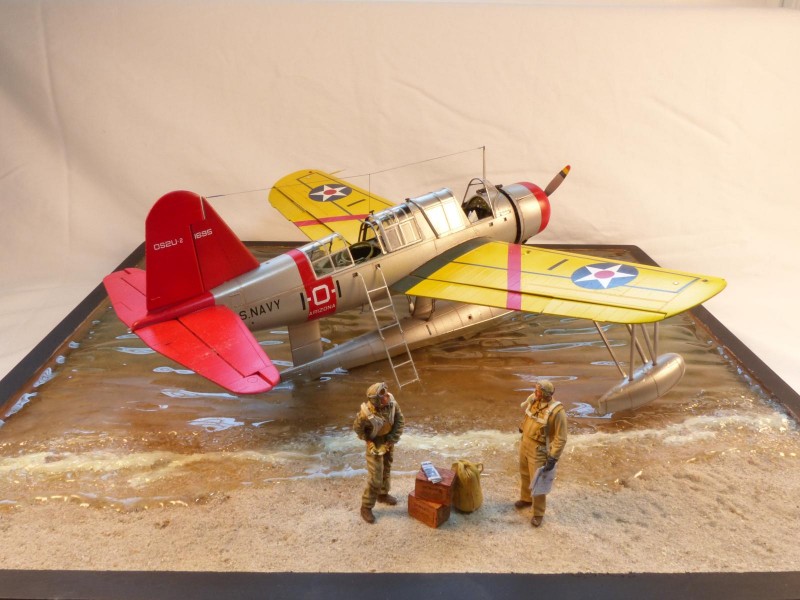

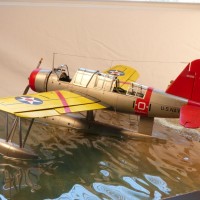
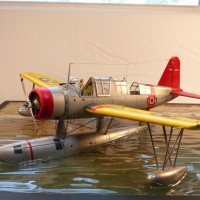
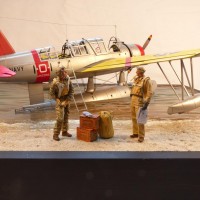
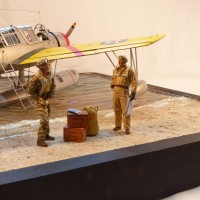
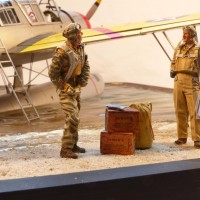
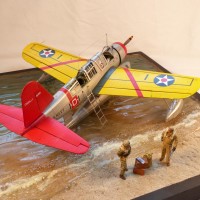
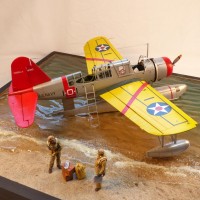
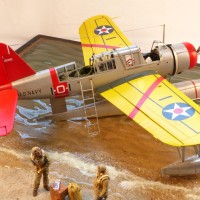
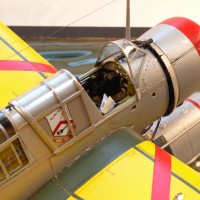
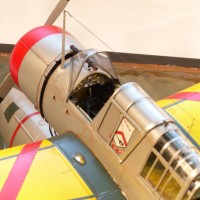
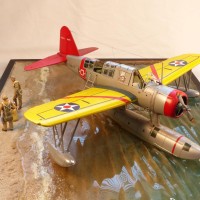
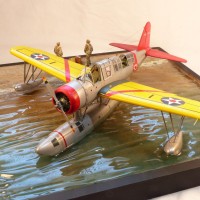
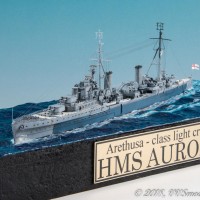
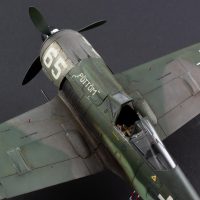
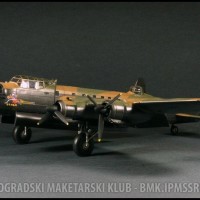
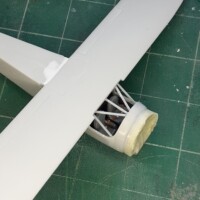
Excellent job Gary. The plane, the water and especially the figures are just spot on!
Ditto, the water really complements the model. What with the waves and then foaming further up the beach just give the illusion of movement in the water and sets the tone for looking at the build. Another , hair pulling build for the judges at the end of the month, Maybe some Rogaine for the judges or some bubbly to calm some nerves. Given all the pressure there under.
Gary, that is really wonderful, man. You definitely nailed it. I love the little details like the map/charts. The water is beautifully rendered, too. The colors, the pilots, the cargo all conribute to a very cohesive and artistic diorama.
Cripes! That is some awesome modeling there. It is Very impressive.
Wonderful job. I love the Kingfisher and you excelled at this one.
They've already said everything I was thinking...great work!
Beautiful dio Gary! Every time I scroll though the pics I see more interesting detail. Nicely done.
Thank you All for the kind comments.
Splendid work, Gary, really top notch modeling. I like everything about this from the aircraft to the figures, and the terrain. Fantastic work.
Gary, that is a wonderful build - and the water is just stunning!
Most of the OS2U's were at NAS Ford Island that morning, only USS West Virginia, Oklahoma and California had theirs on board. Not entirely sure about the crews, but it seems at least some of them were on the ship - see this story: http://www.hawaiinewsnow.com/story/19531030/one-of-last-uss-arizona-survivors-returns-to-ship-for-last-time
Thanks Boris. Thanks for the info and for the link.
Gorgeous! Everything about it is executed brilliantly.
A beautiful build and diorama!
Beautiful work, Gary.
Since you're good at Kingfishers, here's a diorama idea for you: the last Kingfisher rescue of the war and the only rescue of a US flyer from one of the Japanese home islands. August 1945. The whole story is in "Pacific Thunder."
Thanks Tom! Whew, that's quite the story and would make a great diorama. I'll have to add that to my ever growing list of ideas. Thanks for sharing that.
Hello Gary,
Your fictional license is granted. Surely with this very fine result. It shows what a nice color scheme can do for the camera. Regards, Dirk / The Netherlands.
Gary, the water is the best I have seen. I have been looking at this on and off for two days now - and it works so so well. The plane is beautiful, the figures are wonderfully painted and I can't take my eyes off the blinking water! I keep expecting it to move!
Amazing! it's always nice to see a handsome Kingfisher on the water.
The wave looks impressive, could you please describe more for 'sculpted Gel medium and 5min Epoxy' step? I wander how acrylic gel medium can be formed so smoothly like that.
Thanks man! I've had a soft spot for the Kingfisher since I built the Monogram kit many years ago. When I saw the new Kitty Hawk kit I knew I wanted to do this diorama.
Unfortunately I don't have an exact step-by-step process for the water/surf but I'll try: After the main water base completely dried I added randomly placed lines for the surf/waves, using the clear 5min epoxy (referring to pics I found as a guide) . These waves were built and formed to the desired levels and shapes using both the epoxy and Liquitex gel medium. Any sculpting/forming must be done while the material is wet. Because they eventually settle down and smooth out, I form beyond the desired shape and see what they look like after drying. Once I was happy with the form I highlighted the tops with various blues and white, added a thin layer of gel to give the colors some depth and finished with painting all the waves with Pledge/Future floor acrylic . This last step gives a nice wet look. I used the epoxy the most because it dries quickly. The gel was used for filling and to add a different texture. When using the epoxy you need to work quickly and small sections at a time but working it too much will leave you with a milky color. Again, most of my process comes down to trying it out until it looks right for me...after practicing off the finished piece of course. I hope this helps. Good luck.
Gary, beautiful build all around, I really like those pre-war/ early war markings, especially when they're on a well built model. Well done !
Again, thank you all. Much appreciated.
Wow. No idea how I missed this original post, but damn! This is beyond good. It’s museum quality work. Congrats on the win. Very well deserved.
magnifique